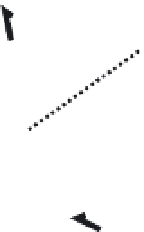Geology Reference
In-Depth Information
Quilitak Fold Scarp
facet slope
uplift
2
31°
ridge
660 m
1
Kilometers
facet
A
dip
0
2
4
6
fold scarp
uplifted surface
erosional
surface
(dip: 2°)
31°
Fig. 9.17
Fold scarps in the
southern Tien Shan.
A. Topographic profile and bedding
dips along a ridge crest in Quilitak
fold. Profile passes through a
triangular facet with a dip of 31
°
,
a height of 660 m, and a length
of
∼
1 km. The facet is interpreted as
a remnant of a fold scarp.
B. Formation of a fold scarp using a
kinematic geometry that is consistent
with the observed structure and
geomorphology. C, D: Perspective
views of fold-scarp facets and
accordant ridge heights that define
the approximate position of the
uplifted strath or pediment. Modified
after Hubert-Ferrari
et al.
(2007).
Kinematic Model
B
accordant crest heights
(surface remnants)
C
D
fold scarp facets
fold scarp facets
Given that Hubert-Ferrari
et al.
's (2007) study
suggests that the Quilitak fold has been
deforming for several million years, why is the
current morphology dominated by a single
folded and moderately eroded paleoerosion
surface? They suggest that, for most of Quilitak's
growth, the sum of erosion of the fold plus
sediment accumulation in the surrounding basin
roughly balanced rock uplift, such that very
little topography developed within the fold,
despite its accommodating several kilometers
of shortening. Within the past 200 kyr, however,
they estimate that shortening rates across
Quilitak increased about six- to eight-fold. As
a consequence of this acceleration, the fold
emerged as a prominent topographic entity that
is dominated by the uplifted erosion surface
that was present just prior to the accelerated
growth (Hubert-Ferrari
et al.
, 2007).
In most sites of active folding, suites of
deformed geomorphic markers that span a wide
age range are absent, such that the temporal
evolution of the shape of a fold becomes
difficult to discern. A tilted fold limb could have
attained its current geometry by maintaining a
constant dip and by lengthening through the
toe of the fold or by lengthening through the
fold's crest, or the limb could have rotated
with a fixed length as in the listric fault model
(Fig. 9.18A). Perhaps surprisingly, the long
profiles of rivers incised into the fold limb
may provide clues about the kinematic pathway
of fold growth (Goode and Burbank, 2011).
Under the assumption that channel incision
rates are linearly proportional to stream power
and that stream power is a function of upstream
catchment area and channel slope, the temporal
evolution of a river's long profile can be modeled
as a function of the limb kinematics (Fig. 9.18B).
A channel on a limb that is lengthening through
its toe, for example, will always have an instan-
taneous incision rate that is maximized at its



































































































































































